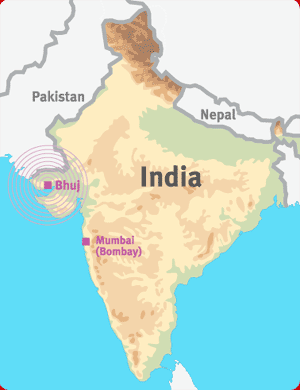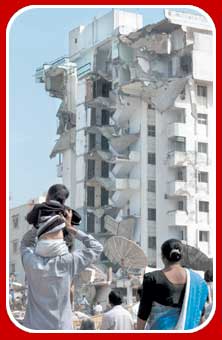| � |
People in Gujarat state
are trying to rebuild their lives after India's worst earthquake
in almost 50 years. The earthquake affected an area the size
of Wales, measuring 7.7 on the Richter scale on 26th January
2001 at 8.46 am local time. Further aftershocks added to the
devastation. 30,000 people are thought to have died, but the
full death toll may never be known as thousands more may have
been buried beneath the rubble.
 This
was the first tectonic activity in the region for seven years.
Geologists believe that during this period, pressure was building
up as the Indo-Australian plate is pushing towards the Eurasian
plate on a collision
plate margin. But
earthquakes don't kill people, buildings do. Rapid urbanisation
combined with population growth in parts of Gujarat means
that there are less open spaces in urban areas and more people
are at risk. Worst hit was the city of Bhuj, located near
the epicentre
of the earthquake. Whole villages surrounding the city were
flattened. This
was the first tectonic activity in the region for seven years.
Geologists believe that during this period, pressure was building
up as the Indo-Australian plate is pushing towards the Eurasian
plate on a collision
plate margin. But
earthquakes don't kill people, buildings do. Rapid urbanisation
combined with population growth in parts of Gujarat means
that there are less open spaces in urban areas and more people
are at risk. Worst hit was the city of Bhuj, located near
the epicentre
of the earthquake. Whole villages surrounding the city were
flattened.
In the immediate aftermath
of the earthquake, people were in a race against time as they
helped rescue teams to dig through the debris in search of
survivors. International rescue teams used thermal imaging
technology to track down signs of people buried under the
rubble, and the Indian government used extra aircraft to fly
some of the injured to other urban centres like Mumbai (Bombay).
Emergency services were at breaking point in their attempts
to cope with the thousands of injured, and to provide food,
water and clothing for the half a million homeless, who had
to bear baking temperatures during the day and bitterly cold
temperatures sleeping out at night. The growing threat of
disease added urgency to the relief effort, and some areas
ran short of the firewood needed to cremate the dead.
| In
Bhuj, modern high rise buildings made of reinforced concrete
were badly hit. Walls and floors pulled away because of
the tremors, causing flats to crash to the ground. |
 �
Popperfoto/Reuters.
�
Popperfoto/Reuters. |
Two months after the earthquake, many people still sleep out
in the open, and the exact death toll is still unknown. Some
towns and villages remain so badly damaged that many people
have decided to move elsewhere, and some towns may be abandoned
altogether.
Lying close to a plate
margin means that the people of Gujarat will continue to live
with the threat of earthquake activity, but all earthquakes
are different, and next time another area could be affected.
In the future, an international rescue system could help to
respond to such disasters more quickly. Locally, lessons can
be learned to reduce the threat to life. Buildings need to
be designed so that they can withstand tremors, but the authorities
have a difficult job in checking building standards in the
rapidly growing towns and cities.
|
� |





